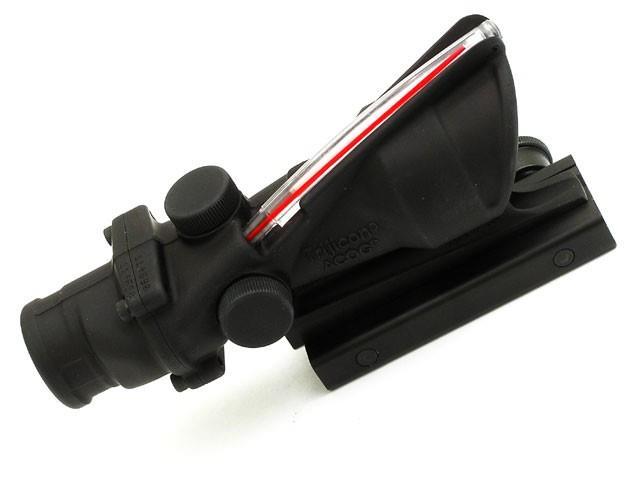My most recent “Introduction to Optics” blog post covered reflex and holographic sights, both of which can help a shooter make hits more rapidly and accurately. In that post, I pointed out that holographic sights, while generally heavier and more expensive than reflex sights, work better for astigmatic shooters. Does that mean that someone with a severe astigmatism is forced to pay extra for an EOTech to get the same capability on his or her rifle when most other people can work with a Holosun at half the price? Not necessarily. There is another option in the realm of short-to-mid-range optical sights that combines some of the advantages of a reflex or holographic sight with some of the advantages of a conventional scope: the prism scope.
First off, let me go into a little more detail about what it means to be astigmatic. When looking through a typical reflex optic with a red dot reticle, someone with normal eyesight will see a bright point of red light, which is a reflection of the LED emitter. Lower-quality reflex sights will often be slightly blurry, whereas the reticle on a top-of-the-line Aimpoint appears as an almost perfect tiny circle. With the brightness on a red dot sight set too high for the ambient lighting conditions, the reticle will appear increasingly blurry, like a starburst. Astigmatism is an imperfection in the shape of the eye causing light sources to appear particularly blurry. Because a reflex sight generates its reticle by directly reflecting a light source; instead of a red dot, an astigmatic shooter will see a directional streak, like looking at a streetlight through an old windshield at night.
If only there was a type of compact, robust optical sight that could be had in an unmagnified configuration for good short-range performance, with an illuminated rather than projected reticle so as to work for astigmatic shooters. Well, prism scopes fill all those criteria, albeit with a few caveats. Externally, many prism scopes look like tube-style reflex sights, but internally, they function more like conventional scopes. Instead of using a series of lenses to magnify the image, however, a prism scope primarily uses… well, prisms. This results in a shorter and more robust optic. Additionally, many prism scopes produce clearer images with less chromatic aberration than similarly priced conventional scopes, though that also depends on glass quality.
Like their conventional counterparts, prism scopes have their reticles physically etched on the glass, allowing them to be more complex than on reflex sights and ensuring they still work even without illumination. Excepting the few self-illuminated models on the market, when a reflex or holographic sight runs out of battery power, it stops working altogether. When a prism scope runs out of battery, it goes from being a day/night optic to being a day optic. Also, because the reticle is illuminated rather than projected directly from a light source, it is still sharp and clear even to an astigmatic eye.
A non-magnified prismatic optics may be a good replacement for a reflex sight for a severely astigmatic shooter, but even more popular are the magnified models. Prism scopes are commonly available with a variety of magnification levels, some up to 6×. In fact, the U.S. military has been using 4×32 prism scopes—specifically Trijicon ACOGs—for more than two decades. With the inherent robustness of the prism system combined with the lack of external focusing or magnification adjustment controls, prism scopes from the Trijicon ACOG and ELCAN Specter families have long been popular in military and law enforcement applications.
If prismatic optics are so great, though, then why aren’t they the universal standard? Well, they come with a few inbuilt disadvantages as compared to conventional scopes and other “red dot” electro-optics. First, because they rely on prisms to transmit the image to the shooter’s eye, they tend to weigh more than reflex and holographic sights, though some very lightweight models are becoming available. Second, because they use internal optics rather than just passing the light through, they do have an eyebox like conventional scopes, albeit often a very forgiving one. Third, because the reticle is illuminated rather than projected, even the most efficient prism scope will burn through its battery relatively quickly, though as mentioned before the optic is still usable without illumination. Fourth, unlike nearly all modern conventional scopes, prism scopes do not have adjustable magnification. ELCAN’s engineers figured out how to cram two or even three prismatic optic systems with different levels of magnification into one housing for their Specter DR and TR optics, respectively, but if you are reading this blog post, you do not own one of those.
All in all, prism scopes can offer a lot of capability, being smaller than conventional scopes and working just fine with or without batteries. If you are astigmatic or have some other issue using a reflex sight but don’t want an EOTech or Vortex UH-1, or if you’re looking for the smallest and lightest magnified optic for a hunting rifle or similar, head down to your local gun store and look through their selection of prism scopes. From the entry-level models Primary Arms makes through Vortex’s midrange options to the supremely expensive ACOG (that TA11 is really sweet), there are certainly a preponderance of options to fill many use cases at many price points. No optic is a one-size-fits-all solution, but I feel the prism scope is somewhat underappreciated.





Comments